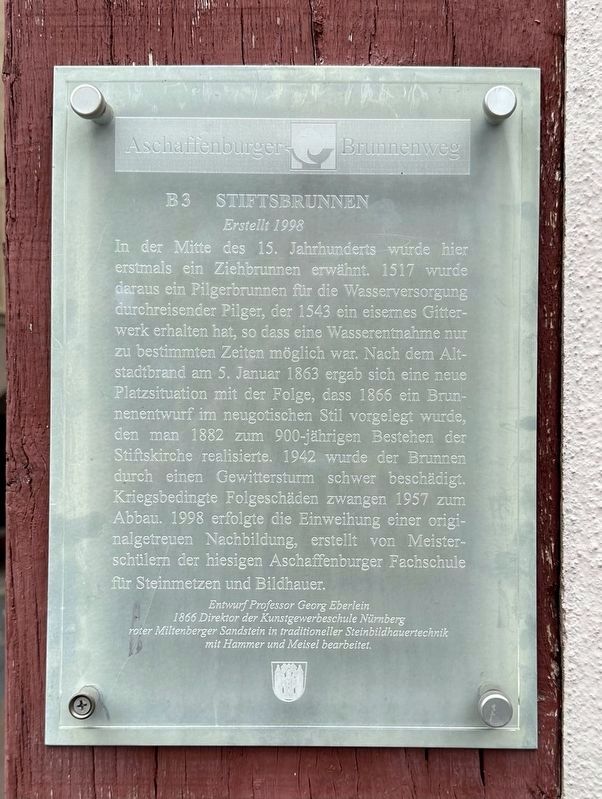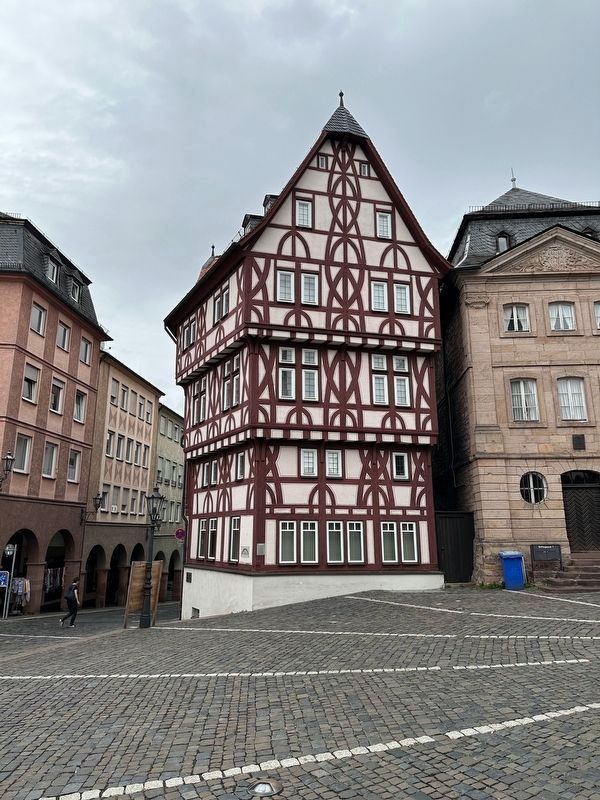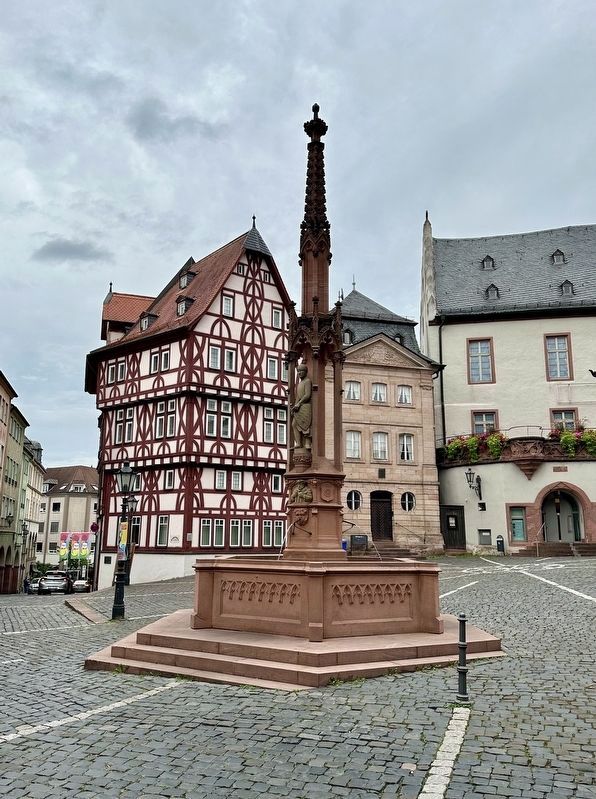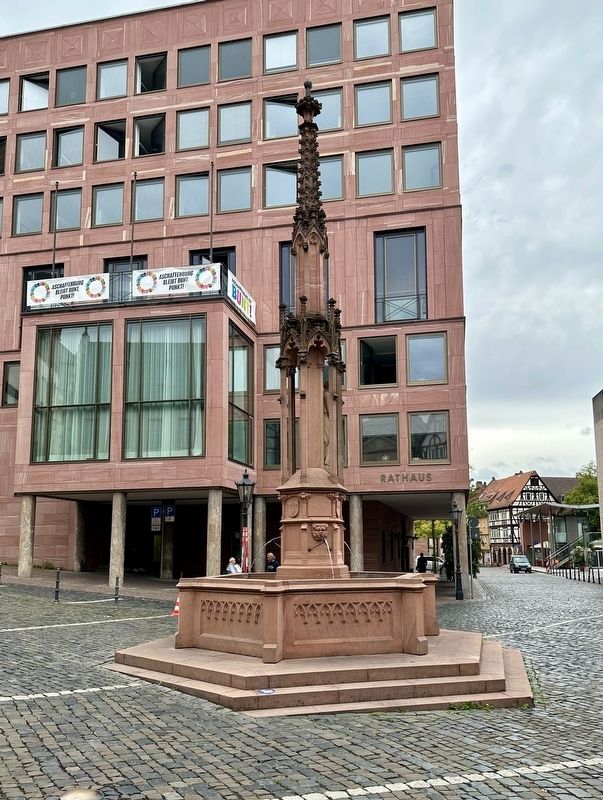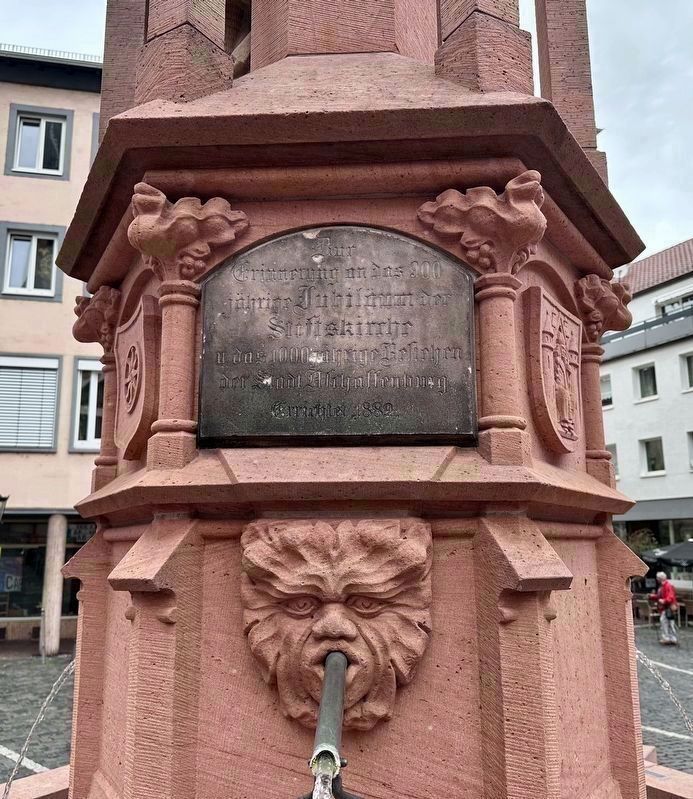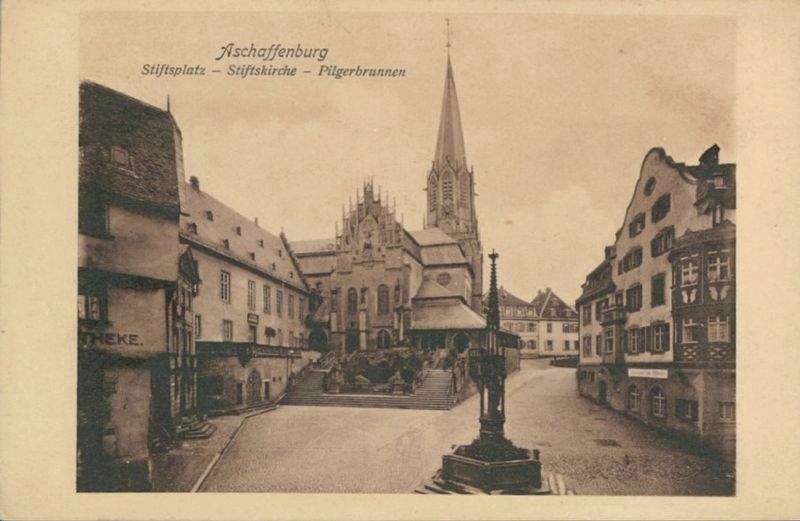Innenstadt in Aschaffenburg, Bavaria, Germany — Central Europe
Stiftsbrunnen / Collegiate Church Fountain
— Aschaffenburger Brunnenweg —
Inscription.
Erstellt 1998
In der Mitte des 15. Jahrhunderts wurde hier erstmals ein Ziehbrunnen erwähnt. 1517 wurde daraus ein Pilgerbrunnen für die Wasserversorgung durchreisender Pilger, der 1543 ein eisernes Gitterwerk erhalten hat, so dass eine Wasserentnahme nur zu bestimmten Zeiten möglich war. Nach dem Altstadtbrand am 5. Januar 1863 ergab sich eine neue Platzsituation mit der Folge, dass 1866 ein Brunnenentwur im neugotischen Stil vorgelegt wurde, den man 1882 zum 900-jährigen Bestehen der Stiftskirche realisierte. 1942 wurde der Brunnen durch einen Gewittersturm schwer beschädigt. Kriegsbedingte Folgeschäden zwangen 1957 zum Abbau. 1998 erfolgte die Einweihung einer originalgetreuen Nachbildung, erstellt von Meisterschülern der hiesigen Aschaffenburger Fachschule für Steinmetzen und Bildhauer.
Entwurf Professor Georg Eberlein 1866 Direktor der Kunstgewerbeschule Nürnberg roter Miltenberger Sandstein in traditioneller Steinbildhauertechnik mit Hammer und Meisel bearbeitet.
Collegiate Church Fountain
Installed 1998
As early as the middle of the 15th century a well was mentioned as being located here. In 1517 it became a well for supplying water to pilgrims passing through. In 1543 it received an iron latticework so that water could only be drawn at certain times. After the old town fire on January 5, 1863, the situation was such that in 1866 a new fountain design in the neo-Gothic style was proposed, the plans for which were finally realized for the 900th anniversary of the Collegiate church in 1882. In 1942 the fountain was badly damaged by a thunderstorm. Consequential damage caused by the war forced it to be dismantled in 1957. In 1998, a true-to-original replica was inaugurated, created by master students from the local Aschaffenburg technical school for stonemasons and sculptors.
Design by Professor Georg Eberlein, Director of the Nuremberg School of Applied Arts, 1866. Red Miltenberg sandstone worked with traditional stone carving technique, using hammer and chisel.
(Marker Number B3.)
Topics. This historical marker is listed in this topic list: Man-Made Features. A significant historical year for this entry is 1998.
Location. 49° 58.439′ N, 9° 8.758′ E. Marker is in Aschaffenburg, Bayern (Bavaria). It is in Innenstadt. Marker is at the intersection of Dalbergstraße and Pfaffengasse, on the right when
traveling north on Dalbergstraße. Touch for map. Marker is at or near this postal address: Dalbergstraße 11, Aschaffenburg BY 63739, Germany. Touch for directions.
Other nearby markers. At least 6 other markers are within walking distance of this marker. Aschaffenburg (a few steps from this marker); Dr. Johannes Kirsch (about 90 meters away, measured in a direct line); Ehemaliger Ballsaal / Former Ballroom (about 120 meters away); Schmerlenbacher Klosterhof / Schmerlenbach Convent (about 180 meters away); Peter Gingold (about 210 meters away); Prinzessin Alexandra Amalie / Princess Alexandra Amalie (approx. 0.4 kilometers away).
Also see . . . Brunnen (Stadt Aschaffenburg, in German). The City of Aschaffenburg‘s page on fountains in the city.
Excerpt (in translation): The Stiftsbrunnen was affected by the severe destruction on Dalbergstrasse during the Second World War. In 1957, the remains of the fountain were probably demolished in connection with the construction of the town hall. In the 1990s, the "new" fountain was built as a reconstruction - after the new “Lion” pharmacy was built. It was originally built in 1882 to commemorate the 900th anniversary of the collegiate church and the 1000th anniversary of the city.(Submitted on December 9, 2023.)
Credits. This page was last revised on December 9, 2023. It was originally submitted on December 9, 2023, by Andrew Ruppenstein of Lamorinda, California. This page has been viewed 39 times since then and 4 times this year. Photos: 1, 2, 3, 4, 5, 6. submitted on December 9, 2023, by Andrew Ruppenstein of Lamorinda, California.
